New to Tapping and looking for a complete guide to the Tapping points?
Not sure if you are Tapping on the right location and want more details on how to tap on each point? Do you simply want to learn more about the Tapping points so you can take your Tapping knowledge even deeper?
Then you’ve come to the right place! Below, we’ll get to know the Tapping points a little bit better – why we use them, where they are located, how to tap on them, and more.
What Is EFT Tapping?

Tapping, also known as EFT (Emotional Freedom Techniques) is a powerful technique that combines the principles of modern psychology and ancient Chinese acupressure.
During a Tapping session, you focus on whatever may be causing you stress or discomfort while at the same time gently tapping with your fingers on a specific set of points on the body.
These points, called Tapping points or EFT Tapping points, correspond to traditional Chinese medicine acupoints found along the body’s meridians.
Tapping on these points sends calming signals to the brain, letting it know that it is safe to relax. It helps to turn down the brain’s stress response so that you can let go of your stress and find more balance, calm, and ease as you move forward.
A Brief Introduction to Meridians and EFT Tapping Points
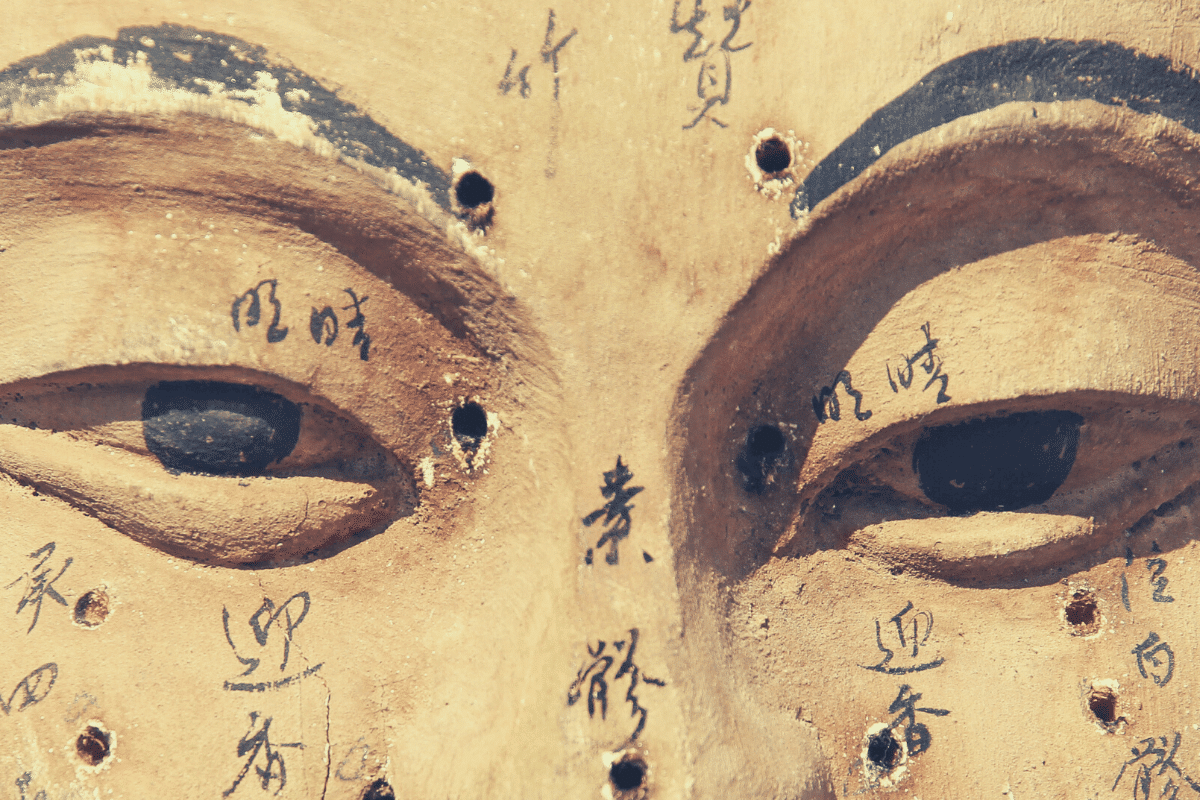
The points that you tap on during a Tapping sequence are found along the body’s meridians.
The concept of meridians comes from traditional Chinese medicine. Meridians are thought to be the energy pathways of the body, through which our vital life force energy flows. Nowadays, researchers believe that the meridians may also be linked to the nervous system and may even influence brain activity.[1,2]
There are twelve major meridians. These exist in symmetrical pairs, with an identical pathway running on each side of the body.
The twelve major meridians, along with many smaller ones, form an intricate network of energy pathways through the body. You can think of the meridians as a roadmap, with major highways running the main routes and smaller side roads branching off from there to form many connections and intersections.
The meridians run through more than 2,000 acupoints across the body, which are used in traditional Chinese medicine practices like acupressure or acupuncture. In those practices, pressure or needles are used to stimulate the points. This is thought to restore the flow of energy and bring balance back to the body’s systems and energy.
In Tapping, we use some of the same acupoints that are used in acupressure and acupuncture, only we stimulate them by using our fingertips to gently tap on the points.
Through the physical act of tapping on the points while thinking or speaking about your source of distress, you are able to send calming signals to the brain and help yourself get back to feeling more balanced and centered. You can read more about how Tapping works here.
Continue on to familiarize yourself with an EFT Tapping chart and learn more about the nine main Tapping points used in the traditional Tapping technique…
EFT Tapping Chart
While there are thousands of accupoints along the body where meridians can be accessed, we usually use a set of nine EFT Tapping points for our traditional Tapping sequence.
There are many ways to Tap, and the process is very adaptable. These nine points were chosen as part of an easy-to-learn and easy-to-repeat sequence that can be applied to a wide range of situations and challenges with a high level of effectiveness.
Here’s a handy EFT Tapping chart to show you where these nine Tapping points are located on the body:
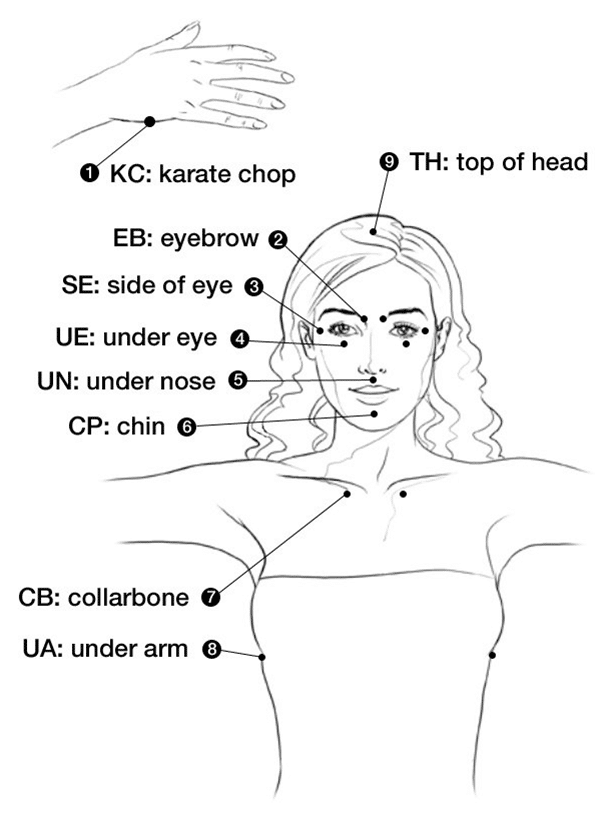
And if you’re looking for a kid-friendly EFT Tapping chart, you can find some fun diagrams to help kids learn Tapping here.
Getting to Know the 9 Main Tapping Points
Today, we are going to focus on the basics, getting more familiar with the nine points used in our traditional Tapping sequence.
We’ll start with the first point in any Tapping sequence – the Side of the Hand (also known as the Karate Chop point).
1. Side of the Hand (Karate Chop – KC)
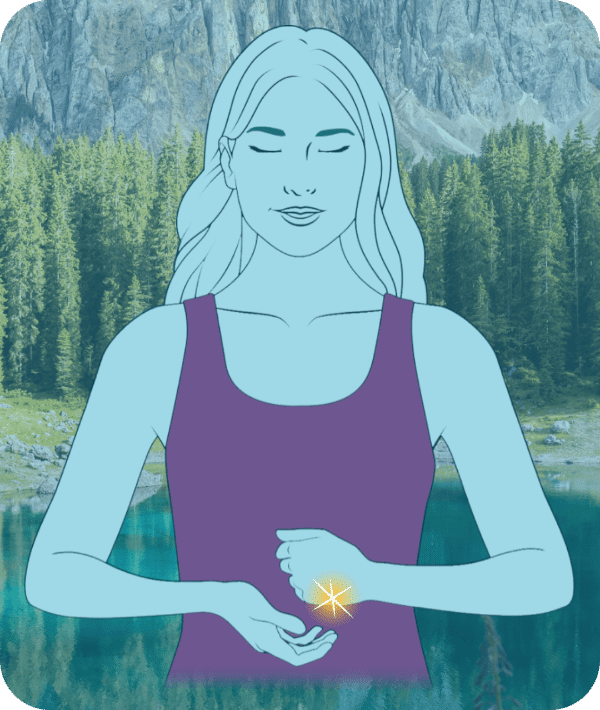 Location:
Location:
The Karate Chop point is found along the fleshy, narrow side of the hand on the side of the pinky finger. It is found on both the left and right hands, between the base of the pinky finger and the wrist. It is often referred to as the Karate Chop point, because this is the part of the hand that you would use to deliver a karate chop.
Corresponding meridian:
Small intestine
Why we use it:
Releases feeling stuck and promotes ease in moving forward, letting go, healing from grief, and becoming happy in the present moment.
Tips for Tapping:
You can tap on either hand, using the opposite hand to do the tapping. Try using several fingers from the opposite hand to tap on this point. I personally like to use all four fingers to tap along the length of the side of my hand to stimulate the Karate Chop point.
2. Eyebrow (EB)
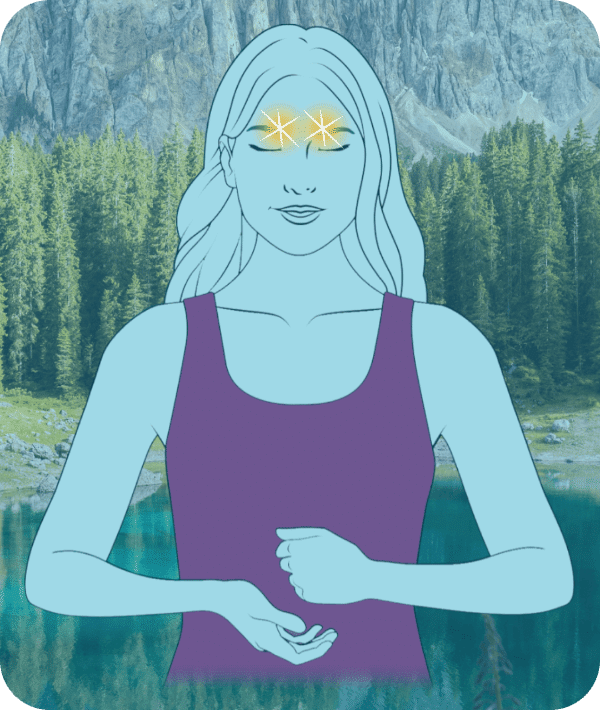 Location:
Location:
This point is where your hair begins on the inner part of your eyebrow, right on the bone there. It is found on both sides of the body, on both the left and the right brow bone.
Corresponding meridian:
Bladder
Why we use it:
Releases trauma, hurt, and sadness and promotes peace and emotional healing.
Tips for Tapping:
You can tap on both sides at once, pick just one side of the body, or alternate sides as you go along. Try using just a few fingers, like the index and middle fingers, to tap on this point.
3. Side of the Eye (SE)
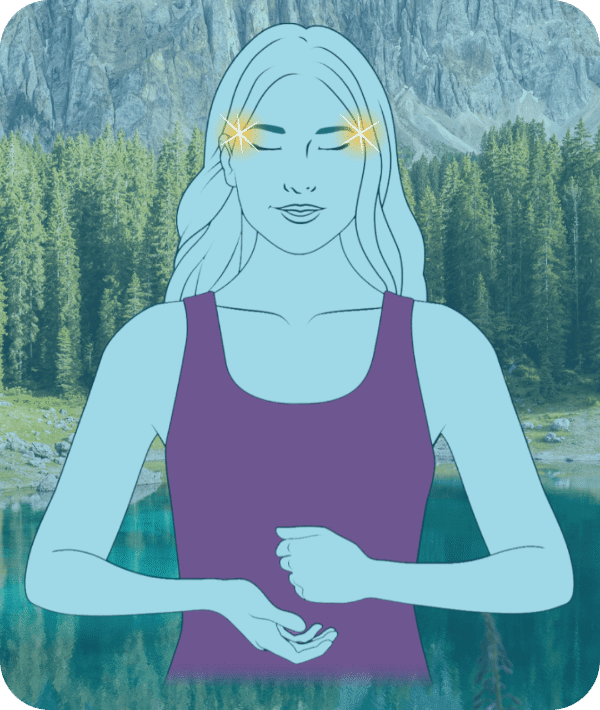 Location:
Location:
From the Eyebrow point, follow that ridge of bone from your eyebrow down to the side of the eye to find this point. Note that the Side of the Eye point is not located in the indent that is your temple; you’ll want to stay on top of the bone instead.
Corresponding meridian:
Gallbladder
Why we use it:
Releases resentment and anger and promotes clarity and compassion.
Tips for Tapping:
You can tap on both sides at once, pick just one side of the body, or alternate sides as you go along. Try using just a few fingers, like the index and middle fingers, to tap on this point.
4. Under the Eye (UE)
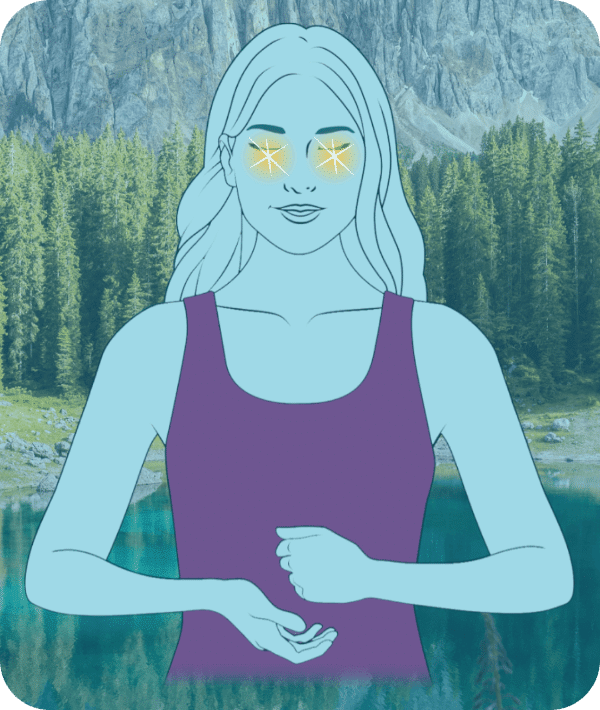 Location:
Location:
From the Side of the Eye Tapping point, follow that ridge of bone once again to come under your eye. This point is found directly under the eye, on either side of the body.
Corresponding meridian:
Stomach
Why we use it:
Releases fear and anxiety and promotes feelings of contentment, calmness, and safety.
Tips for Tapping:
You can tap on both sides at once, pick just one side of the body, or alternate sides as you go along. Try using just a few fingers, like the index and middle fingers, to tap on this point.
5. Under the Nose (UN)
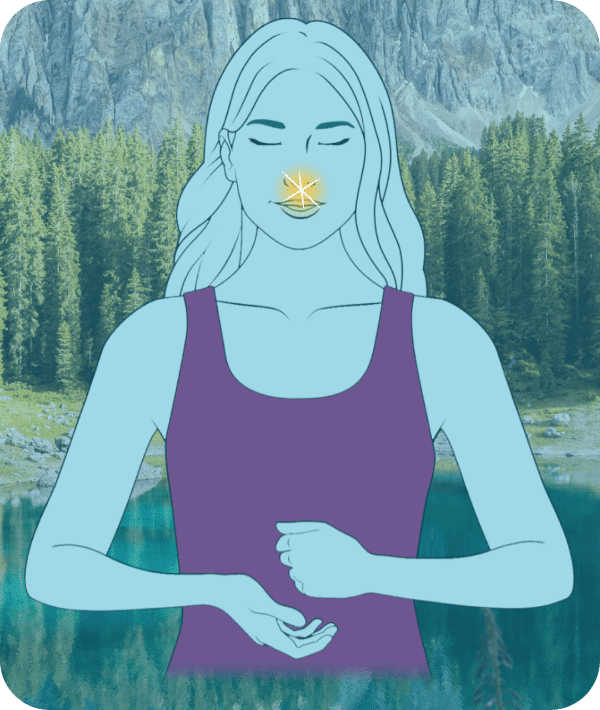 Location:
Location:
This point is found in the space between your nose and upper lip.
Corresponding meridian:
Governing Vessel
Why we use it:
Releases shame and powerlessness and promotes self-acceptance, self-empowerment, and compassion for self and others.
Tips for Tapping:
As it is a small area, try using just a few fingers (like the index and middle fingers) to reach this point for Tapping.
6. Under the Mouth (UM)
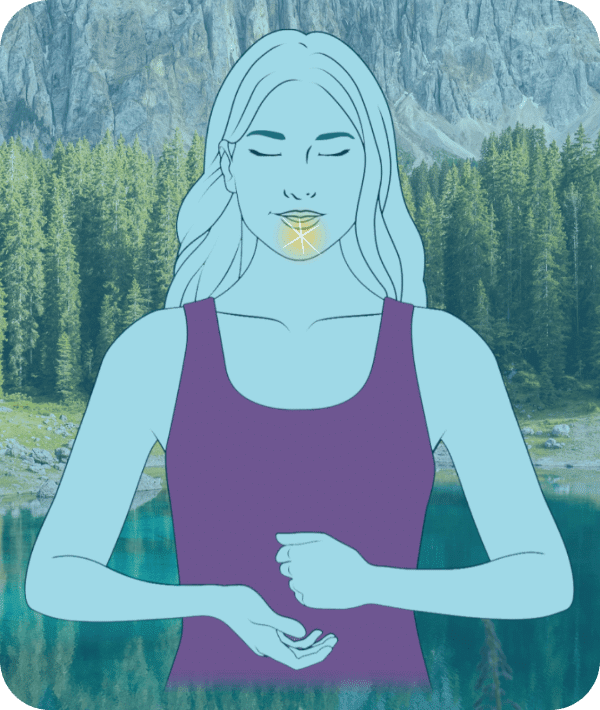 Location:
Location:
Also called the chin point (CP), this point is found in the crease between your chin and bottom lip.
Corresponding meridian:
Central
Why we use it:
Releases confusion and uncertainty and promotes clarity, certainty, confidence, and self-acceptance.
Tips for Tapping:
As it is a small area, try using just a few fingers (like the index and middle fingers) to reach this point for Tapping.
7. Collarbone (CB)
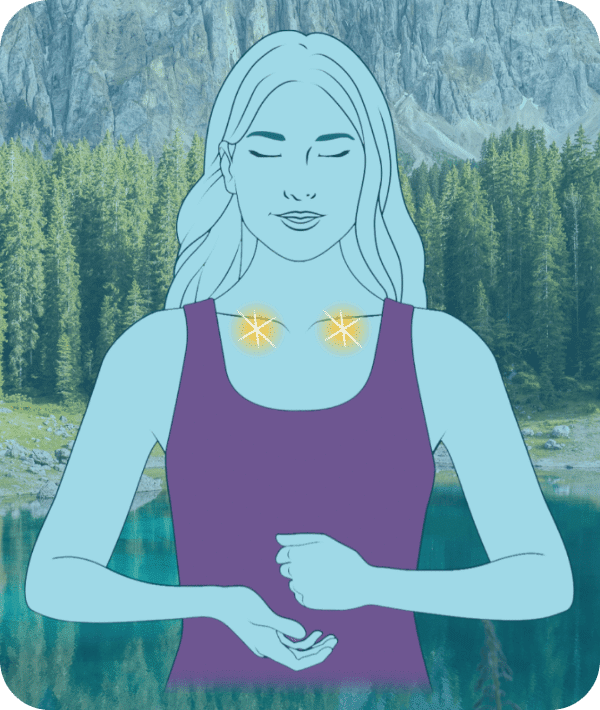 Location:
Location:
Starting from where your collarbones meet in the center (at the base of that U-shape), go down one inch and out one inch to either side to get to the Collarbone point. This Tapping point is found on both the left and right sides of the body.
Corresponding meridian:
Kidney
Why we use it:
Releases the feeling of being stuck, promotes ease in moving forward, and boosts confidence and clarity.
Tips for Tapping:
You can tap with a few fingers on either side of the body to stimulate this point. Alternatively, try taking your whole hand and tapping the entire hand across the place where a bowtie would lie. That allows you to easily stimulate this point on both sides at once without having to worry about the exact location of the point.
8. Under the Arm (UA)
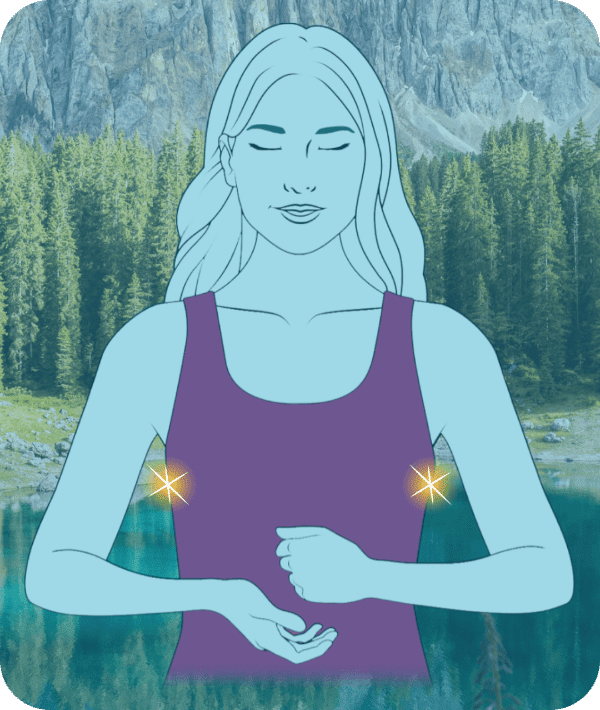 Location:
Location:
This point is located on your side, about four inches (or one hand’s width) below the armpit. That is about where a bra strap lies. It is found on both the left and right sides of the body.
Corresponding meridian:
Spleen
Why we use it:
Releases guilt, worry, and obsessing and promotes clarity, confidence, relaxation, and compassion for self and others.
Tips for Tapping:
The easiest way to stimulate this point is to use all your fingers, or your whole hand, to tap on the side of the body under your arm.
9. Top of the Head (TH)
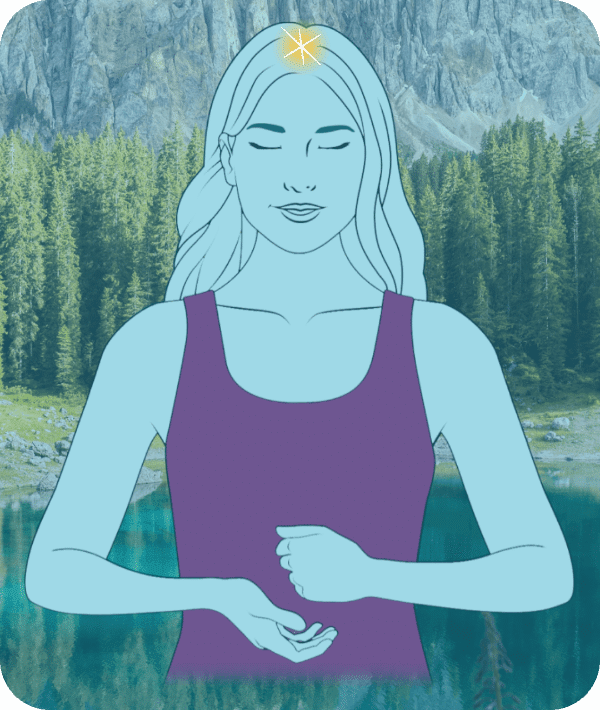 Location:
Location:
This point is right on the center of the top of your head, at the crown.
Corresponding meridian:
This isn’t necessarily one particular point, but rather a collection of many meridian points. Along with being associated with several of the meridians, the Top of the Head point is also connected to the crown chakra.
Why we use it:
Opens the crown chakra and promotes spiritual connection, while anchoring in the new balance and alignment from the tapping round that has just been completed.
Tips for Tapping:
Simply tap your hand or your fingertips at the very top of your head to stimulate this Tapping point.
Note: If you’d like to learn about some of the alternative points that are also sometimes used in Tapping, check out this article. These alternative Tapping points are great substitutes if you don’t want to touch your face, if you can’t reach certain points due to mobility issues, if you’d like to be more discreet with your Tapping process, and so on.
Putting It Into Practice: Using the Tapping Points and the EFT Tapping Chart
Now that you’re more familiar with the Tapping points – where they are, what they do, and how to tap on them, it’s time to get Tapping!
By Tapping on these EFT Tapping points while maintaining mental focus on the problem at hand, you can begin to release your stress and difficult emotions, get yourself back into balance, and find a greater sense of ease and calm as you move forward.
If you are new to Tapping and want to learn more about how to Tap, you can find an introductory guide right here.
You can also head over to The Tapping Solution App, where we have a huge library of Tapping Meditations (a selection of which are free!) designed to walk you through the process and support you with a wide range of different concerns and problems.
The app gives you a handy visual of the EFT points, highlighting in real-time where to tap as you move through each guided meditation.
Until next time…
Keep Tapping!
Nick Ortner
- Instantly reduce anxiety and stress
- Fall asleep faster and sleep better
- Boost productivity, stay motivated
- Relieve chronic or occasional pain
- Release anger, find peace



Is there a specific Tapping point that you have a particular affinity for? Comment below!
References
- Eigenschink M, Dearing L, Dablander TE, Maier J, Sitte HH. A critical examination of the main premises of Traditional Chinese Medicine. Wien Klin Wochenschr. 2020;132(9-10):260-273.
- Longhurst JC. Defining meridians: a modern basis of understanding. J Acupunct Meridian Stud. 2010;3(2):67-74. doi:10.1016/S2005-2901(10)60014-3









Connect With Us on Social Media